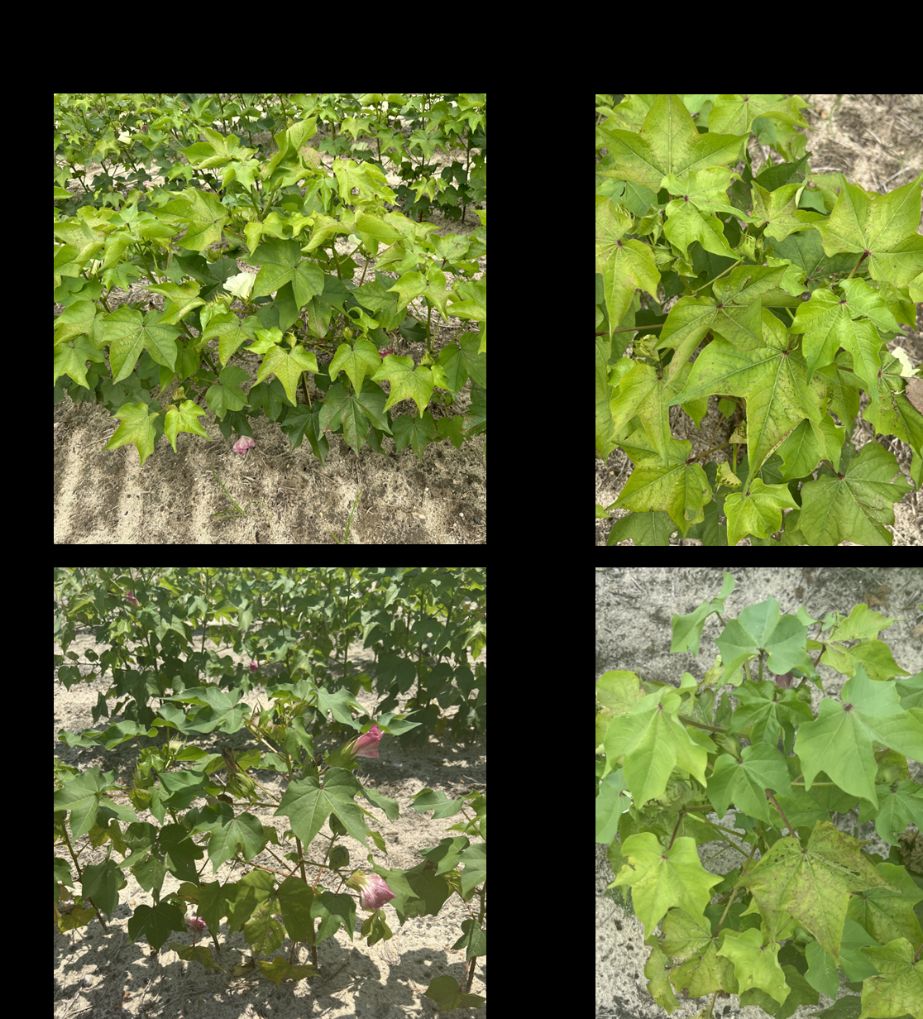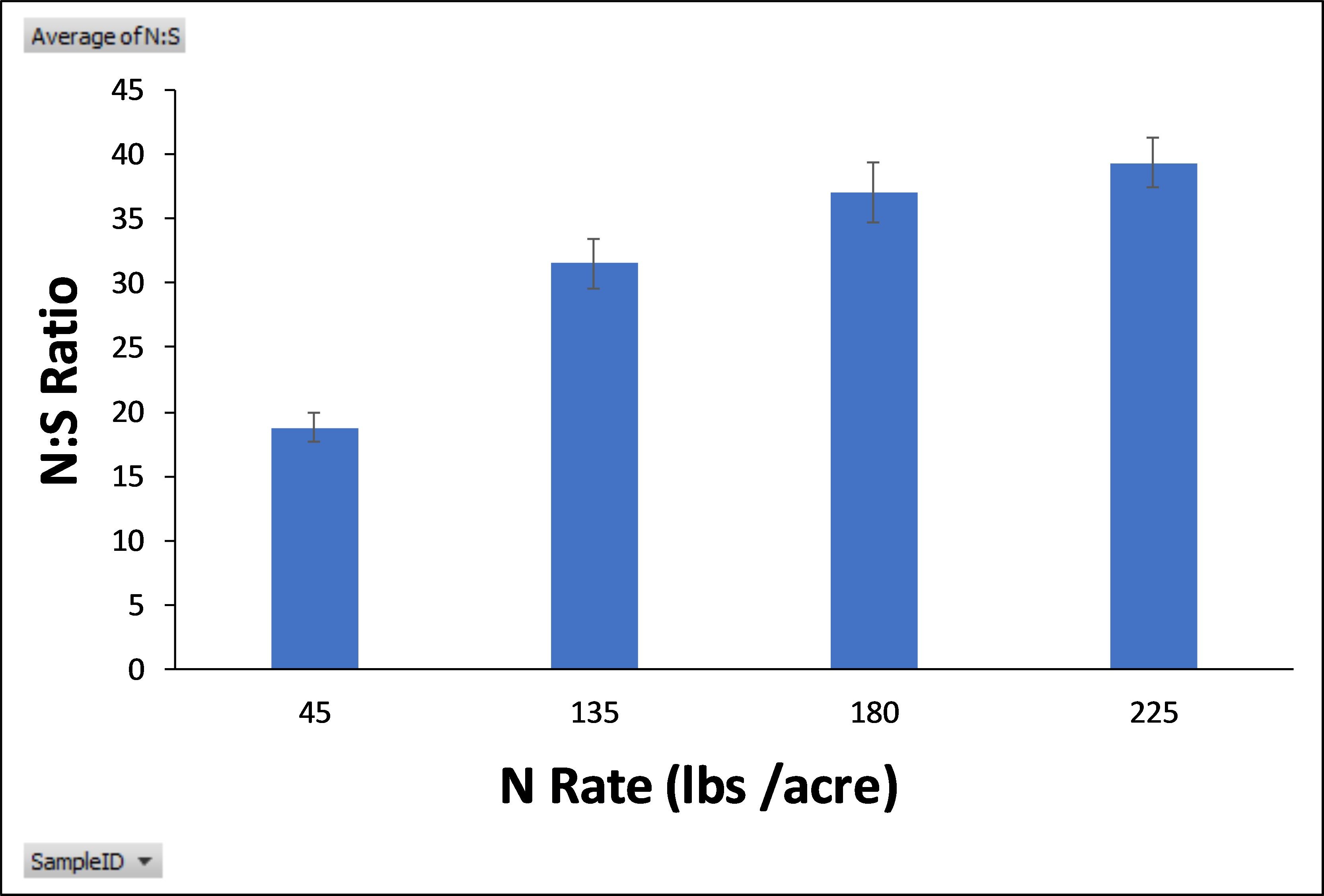Cotton is a crop that is farmed for its fiber all over the globe. Adequate nutrient availability is a critical part of achieving increased yields and improved cotton quality. Nitrogen, phosphorus, and potassium are the elements that are most limiting for cotton production, but other nutrients, such as sulfur and boron, are also critical for optimum cotton yield and quality. In all plants, the synthesis of specific amino acids that are essential components of proteins, enzymes, and chlorophyll depends on sulfur. Sulfur makes up around 3% of the plant's tissue. The purpose of this article is to provide information to cotton farmers, Extension agents, and crop consultants about the symptoms of sulfur deficiency, the various sources of sulfur, and its interaction with changing rates of other major nutrients such as nitrogen.
Sulfur Requirement for Cotton
Based on the literature, in the majority of cases, cotton needs 15–25 lb of sulfur applied per acre in order to achieve its full potential for lint production (Tucker 2000). However, in sandy soils with limited nutrient-holding capacity and high leaching potential, additional application may be necessary to compensate for the leached sulfur that was previously pre-plant applied. Because of this, an increase in lint output may occur as result of the use of sulfur fertilizer in sandy soils compared to loamy soils. Our observations confirmed deficiency in sandy soils in north Florida cotton-producing areas but not in the far-west part of the Florida Panhandle with comparatively heavy soils. It is advised for sulfur to be used as part of the pre-plant fertilizer application to ensure adequate and timely supply. This approach is meant to address any possible sulfur deficits that may have been identified in the past or that may develop throughout the growing season. If pre-plant sulfur application is not possible, including sulfur in the nitrogen side-dress is essential. In a study conducted in Alabama, it was found that the application of 19.6 lb of sulfur per acre resulted in a 21% increase in cotton lint yield when averaged over a span of three years (Mullins 1998).
Reasons for Sulfur Deficiency
In recent years, it has become more common to see sulfur deficiencies in crops. Several factors play a role in sulfur deficiency. Historically, rainfall deposition provided a plentiful supply of sulfur (approximately 10 to 20 pounds). However, farmers can no longer rely on that sulfur supply due to changes in air quality after the implementation of the U.S. Clean Air Act of 1970. About a 90% reduction in sulfur emissions has been reported from manufacturing plants and diesel fuels since 1990. The video, sourced from the National Atmospheric Deposition Program/National Trends Network (https://nadp.slh.wisc.edu/), shows the decline in sulfur deposition across the United States from 1986 to 2019 (Figure 1 and Video 1).
It is clear from Video 1 that the amount of sulfur deposited in 1986, which was about 20 lb/ac, notably diminished to approximately 5 lb/ac by 2019. This decline reflects the changes in sulfur emissions and atmospheric deposition trends during the specified time frame. Sulfur deficiencies have become more prevalent due to high crop yield that exploits the natural sulfur sources (Yu et al. 2019).

Credit: National Atmospheric Deposition Program/National Trends Network
Credit: Videography by Hardeep Singh, UF/IFAS. Imagery by the National Atmospheric Deposition Program/National Trends Network.
Sandy soils, prevalent in cotton-producing regions in Florida, are known to have low levels of sulfur due to their low organic matter content. Organic matter serves as a reservoir for essential nutrients, including sulfur, as it decomposes and releases these nutrients back into the soil. Soils with higher organic matter content can retain sulfur for extended periods, making it available to plants as they grow. In contrast, low organic matter soils cannot effectively retain sulfur, leading to deficiencies in this essential nutrient for plant growth. The sandy texture of these soils makes applied sulfur more prone to leaching, particularly during periods of heavy or prolonged rainfall. Sulfur can easily be washed away from the soil, leading to deficiencies (Yin et al. 2011). Ammonium sulfate, a common fertilizer that contains sulfate-sulfur, is also susceptible to leaching in sandy soils. This concerns cotton growers, especially those who cultivate cotton under irrigation. Additionally, the use of sulfur-free pesticides and the widespread adoption of fertilizers with low or no sulfur content further contribute to sulfur deficiency in soils.
Symptoms of Sulfur Deficiency
Sulfur deficiency in plants can lead to specific visual symptoms. Two of the common symptoms of sulfur deficiency in plants include:
Stunted growth: Sulfur is essential for synthesizing amino acids and proteins, which are crucial for plant growth and development. Plants may experience stunted growth without sufficient sulfur, especially when the petiole nitrogen-to-sulfur ratio is above 18:1. This may lead to reduced size and vigor.
Uniform yellowing of young leaves: Sulfur is involved in chlorophyll synthesis, and chlorophyll is responsible for the green coloration in leaves. When there is a lack of sulfur, young leaves often turn uniformly yellow due to reduced chlorophyll production. Additionally, reddening stems are another symptom of sulfur deficiency. In the event of severe sulfur deficiency, the yellowing may also spread to older leaves.
Differentiating Sulfur Deficiency from Nitrogen Deficiency
Sulfur deficiency in cotton plants can be confused with nitrogen deficiency because both deficiencies can lead to similar yellowing symptoms in the leaves. This similarity in visual symptoms makes it necessary to perform diagnostic tests such as plant tissue and soil sample analysis.
When cotton plants are sulfur deficient, the young leaves near the top of the plant tend to turn uniformly yellow. Nitrogen deficiency, on the other hand, primarily affects the older leaves at the bottom of the plant. Figure 2 demonstrates differences between sulfur and nitrogen deficiency symptoms on different leaves in the cotton canopy.

Credit: Nkem Nwosu, UF/IFAS
To accurately differentiate between sulfur and nitrogen deficiencies in cotton, farmers and agronomists need to consider the following factors:
Fertilizer history: Knowing the fertilizer history of the field can provide insight into previous nutrient applications and help manage for potential deficiencies.
Soil testing: Conducting soil tests can provide soil nutrient status and help determine if sulfur is lacking.
Leaf position: The yellowing of young leaves near the top of the plant is more likely to indicate a sulfur deficiency, while the yellowing of older leaves at the bottom may suggest a nitrogen deficiency.
Leaf tissue analysis: Collecting and analyzing leaf tissue samples can provide accurate information about the plant's nutrient status and help determine the exact deficiency.
Sulfur Sources
Table 1 lists a variety of commercially available sulfur sources.
Table 1. Sources of sulfur with concentrations.
Elemental sulfur (also known as sulfur prills) is a natural form of sulfur that occurs in the environment. It is usually applied to the soil as granules and needs to be converted into sulfate form by soil bacteria before becoming available to plants. Elemental sulfur should be applied as a pre-plant fertilizer. In contrast, other sources such as ammonium sulfate, magnesium sulfate, calcium sulfate, and potassium sulfate provide sulfur to the soil in a readily available form (i.e., sulfate). Therefore, they can be applied as side-dress during the cotton growing season.
Although elemental sulfur and ammonium sulfate are good sulfur fertilizer sources, they are more likely to contribute to soil acidity, especially at high application rates. However, cotton producers applying 15 to 25 pounds of sulfur per acre should not worry about their impact on soil pH.
Organic matter, such as compost, manure, and decaying plant material, can also be a source of sulfur for cotton. As organic matter decomposes, it releases nutrients, including sulfur, into the soil, making them available for plant uptake. However, there are no data confirming how much sulfur fertilizer can be replaced in response to increase in organic matter through use of these amendments. Adopting conservation practices such as reduced tillage and cover cropping and using other organic amendments might help increase soil organic matter content, thereby enhancing the availability of essential nutrients such as sulfur and leading to healthier and more productive crop growth.
Maintaining Nitrogen-to-Sulfur Ratio
Maintaining a nitrogen-to-sulfur ratio (N:S) of 12:1 to 15:1 is essential for optimum nitrogen utilization in cotton (Görmüş 2015; Keg River Chemical Corp 2022). Too much nitrogen and too little sulfur can result in a higher nitrogen-to-sulfur ratio and reduced cotton yield. Figure 3 shows an example of an increase in nitrogen-to-sulfur ratio with increased nitrogen rates. Sulfur fertilization is required if the N:S ratio in the petiole collected at full bloom is greater than 20:1. According to the literature, sulfur fertilization did not contribute to yield increase in cotton with petioles that had an N:S ratio below 20:1 (Wilson et al. 2023).

Credit: Hardeep Singh, UF/IFAS
Take-Home Messages
- Yellowing of young leaves near the top of the plant is more likely to indicate a sulfur deficiency, which is common at first square.
- Heavy rainfall can lead to the leaching of applied sulfur, especially in sandy soils, resulting in sulfur deficiency.
- Application of 15 to 25 pounds of sulfur per acre is a common practice for optimal lint production in the region. However, cotton growers need soil test reports for specific recommendations.
- Use in-season tissue sampling and test to adjust side-dress rate if deficiency still shows up after adequate pre-plant sulfur was applied.
- Ammonium sulfate and magnesium sulfate are reported to work best as sources of sulfur when used as side-dress application at early bloom.
- Maintain the ratio of 15:1 to 18:1 when selecting the rates for nitrogen and sulfur fertilizers.
- If using elemental sulfur as a source of sulfur, apply it at planting.
- Improving the soil health/organic matter content by adopting conservation practices such as cover cropping and no-tillage might reduce the likelihood of sulfur deficiency by helping to retain sulfur in soil.
References
Görmüş, Ö. 2015. “Evaluation of Cotton Growth and Yield Response to Nitrogen and Sulfur Fertilization—I.” Süleyman Demirel Üniversitesi Ziraat Fakültesi Dergisi 10 (1): 1–7.
Keg River Chemical Corp. 2022. “Keys to Preventing Sulfur Deficiency in Cotton.” https://kegriver.com/keys-to-preventing-sulfur-deficiency-in-cotton/
Mullins, G. L. 1998. “Cotton Response to the Rate and Source of Sulfur on a Sandy Coastal Plain Soil.” Journal of Production Agriculture 11 (2): 214–218. https://doi.org/10.2134/jpa1998.0214
National Atmospheric Deposition Program (NRSP-3). 2022. NADP Program Office, Wisconsin State Laboratory of Hygiene, 465 Henry Mall, Madison, WI 53706. https://nadp.slh.wisc.edu/networks/national-trends-network/
Tucker, M. R. 2000. “Cotton needs sulfur on Coastal Plain soils.” North Carolina Department of Agriculture & Consumer Services. https://www.ncagr.gov/agronomi/release/5-00agrosulf.htm#:~:text=Cotton%20needs%20from%2015%20to,lint%20production%20under%20most%20circumstances
Wilson, B., G. Stevens, and D. Dunn. 2023. “Sulfur and Boron Fertilization on Cotton.” University of Missouri Extension. https://extension.missouri.edu/publications/g4257
Yin, X., O. Gwathmey, C. Main, and A. Johnson. 2011. “Effects of Sulfur Application Rates and Foliar Zinc Fertilization on Cotton Lint Yields and Qualities.” Agronomy Journal 103 (6): 1794–1803. https://doi.org/10.2134/agronj2011.0166
Yu, J., X. Yin, T. B. Raper, and S. Jagadamma. 2019. “Sulfur Fertilization and Sulfur Sufficiency Range for Contemporary Cotton Cultivars with High Yielding Potentials.” International Journal of Plant Production 13:369–378. https://doi.org/10.1007/s42106-019-00061-9
VIDEO DESCRIPTION: The National Atmospheric Deposition Program's animated map of the United States depicts the state of sulfur as sulfate ion moist deposition from 1986 to 2019. In the video, the red hue denotes a higher sulfate deposit in kilograms per hectare, while the green color denotes a lower deposit. In 1986, the map showed more red areas, particularly in the eastern part of the country, where sulfate ions might reach 24 kg per hectare. The map gradually becomes greener, with less than 4 kg per hectare by 2019. In Florida, sulfur deposition decreased significantly between 2000 and 2019, from about 20 kg per hectare (17.8 lb per acre) of sulfate to less than 4 kg per hectare (3.7 lb per acre).